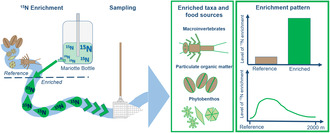- Record: found
- Abstract: found
- Article: found
Stable isotopes ( 15N) facilitate non‐invasive labelling of large quantities of macroinvertebrates across different species and feeding types

Read this article at
Abstract
While macroinvertebrate dispersal operates at the individual level, predictions of their dispersal capabilities often rely on indirect proxies rather than direct measurements. To gain insight into the dispersal of individual specimens, it is crucial to mark (label) and capture individuals. Isotopic enrichment with 15N is a non‐invasive method with the potential of labelling large quantities of macroinvertebrates. While the analysis of 15N is widely utilised in food web studies, knowledge on the specific utility of isotopic enrichment with 15N for mass labelling of macroinvertebrate individuals across different taxa and feeding types is limited. Previous studies have focused on single species and feeding types, leaving gaps in our understanding of the broader applicability of this method. Therefore, this study aimed to test and compare isotopic mass enrichment across several macroinvertebrate taxa and feeding types. We released 15NH 4Cl at five stream reaches in North‐Rhine Westphalia, Germany, and successfully enriched 12 distinct macroinvertebrate taxa (Crustacea and Insecta). Significant enrichment was achieved in active and passive filter feeders, grazers, shredders and predators, and predominantly showed positive correlations with the enrichment of the taxa's main food sources phytobenthos and particulate organic matter. Enrichment levels rose rapidly and peaked at distances between 50 m and 300 m downstream of the isotopic inlet; significant enrichment occurred up to 2000 m downstream of the isotopic inlet in all feeding types. Macroinvertebrate density estimates on the stream bottom averaged to a total of approximately 3.4 million labelled individuals of the 12 investigated taxa, thus showing the high potential of isotopic ( 15N) enrichment as a non‐invasive method applicable for mass labelling across different macroinvertebrate feeding types. Hence, isotopic enrichment can greatly assist the analysis of macroinvertebrate dispersal through mark‐and‐recapture experiments, as it allows to measure the movement at the level of individual specimens.
Abstract
Isotopic enrichment offers a non‐invasive approach to label macroinvertebrates and contributes to our understanding of dispersal dynamics in aquatic ecosystems. By releasing 15NH 4Cl into stream reaches, we successfully labelled 3 million individuals of 12 macroinvertebrate taxa and observed significant enrichment up to 2000 m downstream, demonstrating the method's general applicability for labelling large amounts of macroinvertebrates.
Related collections
Most cited references48
- Record: found
- Abstract: not found
- Article: not found
Dispersal in Freshwater Invertebrates
- Record: found
- Abstract: not found
- Article: not found
www.freshwaterecology.info – An online tool that unifies, standardises and codifies more than 20,000 European freshwater organisms and their ecological preferences
- Record: found
- Abstract: not found
- Article: not found
